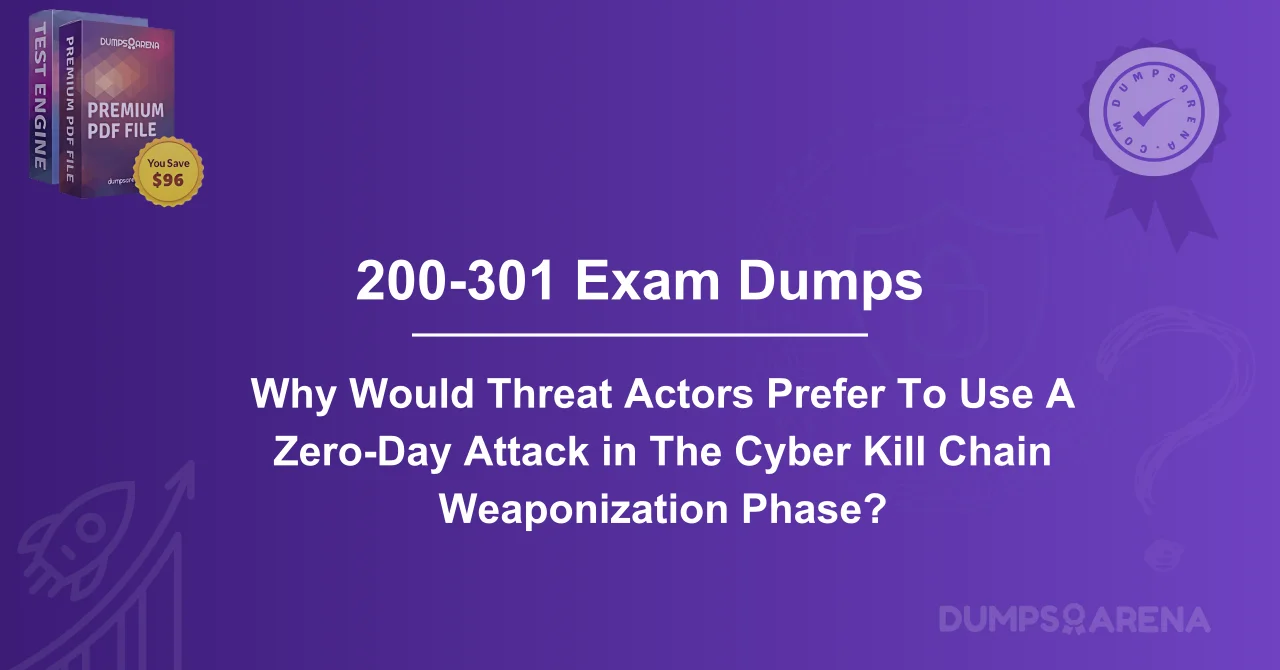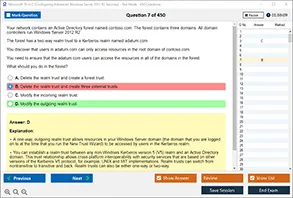Introduction
In the ever-evolving landscape of cybersecurity, threat actors constantly seek new ways to exploit vulnerabilities and infiltrate systems. One of the most potent tools in their arsenal is the zero-day attack, particularly during the Weaponization Phase of the Cyber Kill Chain. But why do attackers prefer zero-day exploits at this stage? This article explores the strategic advantages of zero-day attacks in the Weaponization Phase, their relevance in cybersecurity certifications like the Cisco 200-301 exam, and how platforms like DumpsArena help professionals stay ahead in defending against such threats.
Understanding the Cyber Kill Chain and the Weaponization Phase
The Cyber Kill Chain, developed by Lockheed Martin, is a framework that outlines the stages of a cyberattack. It helps security professionals identify and disrupt attacks before they cause damage. The seven phases are:
- Reconnaissance – Gathering target information.
- Weaponization – Creating malicious payloads.
- Delivery – Transmitting the payload to the victim.
- Exploitation – Triggering the vulnerability.
- Installation – Establishing persistence.
- Command and Control (C2) – Remote manipulation.
- Actions on Objectives – Achieving the attacker’s goal.
The Weaponization Phase is where attackers craft their malicious tools—such as malware, ransomware, or exploit kits—to take advantage of vulnerabilities.
Why Zero-Day Attacks Are Preferred in the Weaponization Phase?
A zero-day attack exploits a previously unknown vulnerability for which no patch or defense exists. Here’s why attackers favor them in the Weaponization Phase:
1. No Existing Defenses
Since zero-day vulnerabilities are unknown to vendors, there are no patches, signatures, or detection mechanisms in place. This makes them highly effective for bypassing security controls.
2. Higher Success Rate
Traditional attacks rely on known exploits that security systems can detect. Zero-day attacks, however, evade antivirus, firewalls, and intrusion detection systems (IDS) because they exploit undisclosed flaws.
3. Stealth and Persistence
Zero-day exploits allow attackers to remain undetected for extended periods, enabling long-term espionage, data exfiltration, or system control.
4. High-Value Target Exploitation
Attackers use zero-days against high-profile targets (governments, corporations, critical infrastructure) where standard attacks may fail.
5. Financial and Strategic Gains
Zero-day exploits are sold on the dark web for substantial sums, making them lucrative for cybercriminals. Nation-state actors also use them for cyber warfare.
Zero-Day Attacks in the Context of the Cisco 200-301 Exam
The Cisco Certified Network Associate (CCNA) 200-301 exam covers essential cybersecurity concepts, including threat vectors, attack methodologies, and mitigation strategies. Understanding zero-day attacks is crucial because:
1. Threat Identification
The exam tests knowledge of different attack types, including zero-day exploits, and how they fit into the Cyber Kill Chain.
2. Security Mitigation Strategies
Candidates must learn defense mechanisms like:
- Patch management (though ineffective for zero-days until disclosed).
- Behavioral analysis (detecting anomalies rather than relying on signatures).
- Network segmentation (limiting lateral movement post-exploitation).
3. Incident Response
The 200-301 exam emphasizes incident handling, requiring professionals to recognize zero-day attack indicators and respond effectively.
How DumpsArena Helps in Preparing for Zero-Day Attack Scenarios?
For cybersecurity professionals and Cisco Exam aspirants, staying updated on emerging threats like zero-day exploits is critical. DumpsArena provides:
1. Updated Study Materials
- Real-world zero-day attack case studies.
- Detailed explanations of Cyber Kill Chain phases.
2. Practice Exams with Scenario-Based Questions
- Simulated questions on zero-day exploit detection and mitigation.
- Cisco 200-301 exam dumps with latest threat intelligence.
3. Expert Insights
- Guides on behavioral defense strategies against unknown threats.
- Breakdowns of recent zero-day attacks and their impact.
By leveraging DumpsArena’s resources, professionals can enhance their readiness for both certification exams and real-world cyber defense.
Conclusion
Zero-day attacks are a preferred weapon in the Cyber Kill Chain’s Weaponization Phase due to their stealth, high success rate, and lack of existing defenses. For cybersecurity professionals, understanding these threats is vital—especially for those pursuing certifications like the Cisco 200-301 exam. Platforms like DumpsArena play a crucial role in equipping learners with the knowledge and tools needed to combat such advanced threats.
As cyber threats grow more sophisticated, continuous learning and proactive defense strategies remain the best countermeasures against zero-day exploits.
Get Accurate & Authentic 500+ Cisco 200-301 Exam Questions
1. Why would threat actors prefer to use a zero-day attack in the Weaponization phase of the Cyber Kill Chain?
A) Because zero-day attacks are cheaper to execute than known exploits
B) Because zero-day exploits are undetectable by traditional security defenses
C) Because zero-day attacks require no prior reconnaissance
D) Because zero-day attacks guarantee immediate system compromise
2. What makes zero-day vulnerabilities particularly valuable in the Weaponization phase?
A) They are widely available on the dark web
B) They have no existing patches or signatures, making them highly effective
C) They can only be used once before being detected
D) They require minimal skill to exploit
3. How does a zero-day exploit enhance an attacker’s success in the Weaponization phase?
A) By ensuring the attack is untraceable
B) By bypassing existing security measures that rely on known threat signatures
C) By automatically spreading to other systems
D) By requiring user interaction to execute
4. Which of the following is a key advantage of zero-day attacks for threat actors during Weaponization?
A) They are easy to obtain legally
B) They have a low success rate, making them unpredictable
C) They evade detection by antivirus and intrusion detection systems
D) They only work on outdated systems
5. Why might an APT (Advanced Persistent Threat) group prefer zero-day exploits in the Weaponization stage?
A) They allow for long-term access without immediate detection
B) They are less effective than known exploits
C) They require frequent updates to remain effective
D) They are only useful for low-value targets
6. What is a major risk for attackers when using zero-day exploits in Weaponization?
A) The exploit may be discovered and patched quickly, reducing its usefulness
B) The exploit requires too much bandwidth to deploy
C) The exploit only works in virtual environments
D) The exploit is always detected by firewalls
7. How does a zero-day attack differ from a known vulnerability attack in the Weaponization phase?
A) Zero-day attacks rely on publicly available patches
B) Zero-day attacks have no existing defenses or fixes
C) Zero-day attacks are slower to execute
D) Zero-day attacks only target hardware vulnerabilities
8. Which of the following best describes why zero-day exploits are a preferred weaponization method for sophisticated attackers?
A) They are easy to detect and trace back to the attacker
B) They allow attackers to remain undetected while bypassing security controls
C) They require minimal financial investment
D) They only work in isolated lab environments
9. In the context of the Cyber Kill Chain, why is Weaponization with a zero-day exploit harder to defend against?
A) Because zero-day exploits require physical access to the target
B) Because security systems lack signatures or behavioral patterns to detect them
C) Because they only affect non-critical systems
D) Because they are always used in combination with phishing
10. What is a potential downside for attackers when using zero-day exploits in Weaponization?
A) They are too expensive to develop or purchase
B) They are guaranteed to work on all systems
C) They can only be used by state-sponsored hackers
D) They require no testing before deployment




